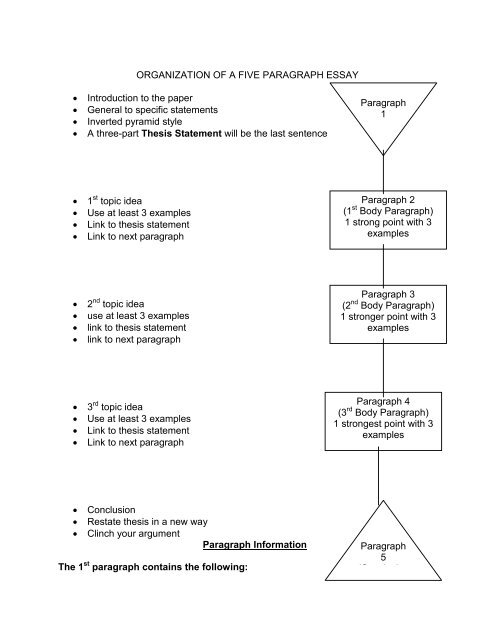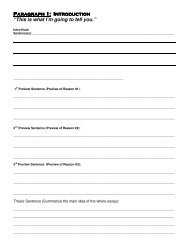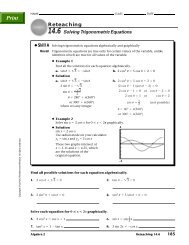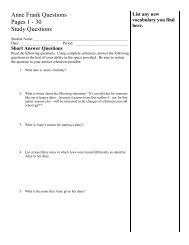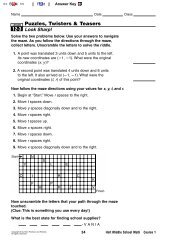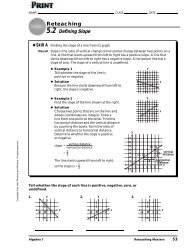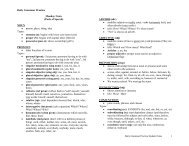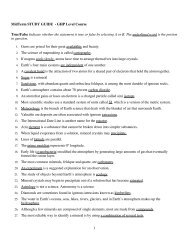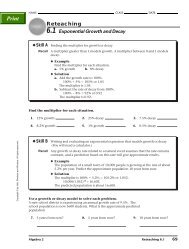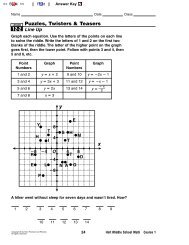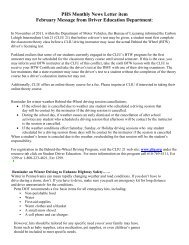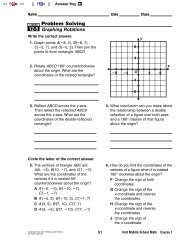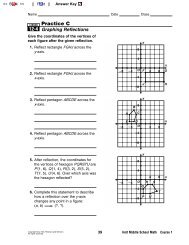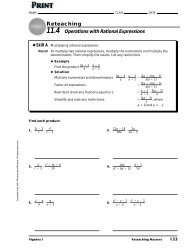Five Paragraph Essay Guidelines
Five Paragraph Essay Guidelines
Five Paragraph Essay Guidelines
You also want an ePaper? Increase the reach of your titles
YUMPU automatically turns print PDFs into web optimized ePapers that Google loves.
ORGANIZATION OF A FIVE PARAGRAPH ESSAY<br />
• Introduction to the paper<br />
• General to specific statements<br />
• Inverted pyramid style<br />
• A three-part Thesis Statement will be the last sentence<br />
<strong>Paragraph</strong><br />
1<br />
• 1 st topic idea<br />
• Use at least 3 examples<br />
• Link to thesis statement<br />
• Link to next paragraph<br />
<strong>Paragraph</strong> 2<br />
(1 st Body <strong>Paragraph</strong>)<br />
1 strong point with 3<br />
examples<br />
• 2 nd topic idea<br />
• use at least 3 examples<br />
• link to thesis statement<br />
• link to next paragraph<br />
<strong>Paragraph</strong> 3<br />
(2 nd Body <strong>Paragraph</strong>)<br />
1 stronger point with 3<br />
examples<br />
• 3 rd topic idea<br />
• Use at least 3 examples<br />
• Link to thesis statement<br />
• Link to next paragraph<br />
<strong>Paragraph</strong> 4<br />
(3 rd Body <strong>Paragraph</strong>)<br />
1 strongest point with 3<br />
examples<br />
• Conclusion<br />
• Restate thesis in a new way<br />
• Clinch your argument<br />
<strong>Paragraph</strong> Information<br />
The 1 st paragraph contains the following:<br />
<strong>Paragraph</strong><br />
5<br />
(Conclusion
1. A topic sentence (A very general sentence that gives a hint as to what will<br />
follow in the paragraph)<br />
2. The next sentence (or sentences) narrow down the topic and establish a<br />
more definite direction that the paper is taking<br />
3. The last sentence of the first paragraph is the thesis statement. The thesis<br />
statement is a one-sentence explanation of the entire paper. This sentence<br />
should have three parts (1 for each body paragraph) Example: Students<br />
should be required to wear school uniforms because they _______________,<br />
___________________, and _________________.<br />
The 2 nd paragraph takes the first point of the thesis and examines it.<br />
1. This paragraph should start with a topic sentence that states the first point of the<br />
thesis<br />
2. This paragraph should include details and examples which explain or prove the<br />
topic sentence.<br />
3. The paragraph should end with a transition to the next paragraph.<br />
The 3 rd paragraph examines the 2 nd point of the thesis.<br />
1. This paragraph should start with a topic sentence that states the 2 nd point of the<br />
thesis<br />
2. This paragraph should include details and examples which explain or prove the<br />
topic sentence.<br />
3. The paragraph should end with a transition to the next paragraph.<br />
The 4 th paragraph examines the 3 rd point of the thesis.<br />
1. This paragraph should start with a topic sentence that states the 3 rd (and<br />
strongest) point of the thesis.<br />
2. This paragraph should include details and examples which explain or prove the<br />
topic sentence.<br />
3. The paragraph should end with a transition to the next paragraph.<br />
The 5 th paragraph is the conclusion.<br />
Along with a restatement of the thesis, this paragraph should also highlight points<br />
covered, and the support used to discuss it.
Helpful Writing Hints<br />
1. The essay must contain UNITY. All of the sentences in a paragraph must be related.<br />
2. The essay must contain COHERENCE. All of the sentences must be logically and<br />
clearly related to one another and their total effect is the clear development of the<br />
paragraph’s tone.<br />
3. Use COMPLETE SENTENCES. Do not use fragments. Do not use run-ons. Avoid<br />
trite/overused expressions (ex. cute, pretty, good, got, very stuff, a lot). Avoid slang<br />
(gonna, like, gotta, shoulda, coulda, probly (probably), cuz, tuff, u) *Slang is becoming<br />
more and more of an issue because of instant messenger.<br />
4. Use CONSISTENT VERB TENSE. Stay with the same verb tense throughout the entire<br />
paper. If writing about a short story, film, novel, play, etc., students should write in the<br />
present tense.<br />
5. WRITE OBJECTIVELY. Do not use first person or second person. Write in third person<br />
(unless the prompt suggests otherwise).<br />
Singular<br />
Plural<br />
First person I, my, me, mine we, our, ours us<br />
(the person speaking)<br />
Second person you, your, yours you, your,<br />
yours<br />
(the person spoken to)<br />
Third person he, his, him, she, her, they , their<br />
(some other person or thing spoken about) hers, it, its theirs, them<br />
6. DO NOT USE CONTRACTIONS in formal writing (shouldn’t, wouldn’t, can’t)<br />
7. DO NOT USE SIGNS or ABBREVIATIONS (&, “ (for inches), w/, b/c, Jan., OMS).<br />
Abbreviations that are accompanied by a name, date, or time are acceptable (John<br />
Jones, M.D., or Mrs. Jones, 984 B.C., 2:30p.m.)<br />
PSSA PROMPT TYPES<br />
General Tips: *Use five paragraph format. * Organize thoughts before writing (outline).<br />
*Use specific details and examples. *Know the directions!<br />
Narrative Prompt:<br />
-you are telling a story<br />
-you may use first person<br />
-provide details of the event<br />
to paint a picture in the<br />
reader’s mind.<br />
-use descriptive adjectives<br />
to make your story come<br />
alive<br />
Informational Prompt:<br />
-provide details (how to,<br />
explain)<br />
-consider the reader to be<br />
inexperienced<br />
-consider all aspects of the<br />
topic<br />
Persuasive Prompt:<br />
-inform audience, consider<br />
audience type<br />
-acknowledge all sides<br />
-use supporting points to<br />
sway readers


